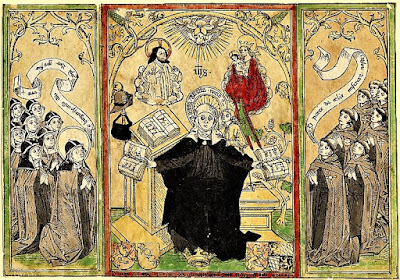 |
| St Bridget presenting the Rule of the Brigittine Order. |
Born of a wealthy family in 1302, Saint Bridget, also known as Birgitta, was related to many members of the royalty. In 1316, at the age of 14, she married Ulf Gudmarsson to whom she bore eight children, four daughters, and four sons. Six survived infancy, which was rare at that time. One daughter is now honored as St. Catherine of Sweden. Bridget became known for her works of charity, particularly toward Östergötland's unwed mothers and their children. When she was in her early thirties, she was summoned to be a lady-in-waiting to the new Queen of Sweden. In 1341 she and her husband went on pilgrimage to Santiago de Compostela, in Spain.
In 1344, shortly after their return, Ulf died at the Cistercian Alvastra Abbey in Östergötland. After this loss, Birgitta became a member of the Third Order of St. Francis and devoted herself wholly to a life of prayer and caring for the poor and the sick. It was about this time that she developed the idea of establishing the religious community which was to become the Order of the Brigittines, whose principal house at Vadstena was later richly endowed by King Magnus IV of Sweden and his queen. One distinctive feature of the pre-Reformation houses of the Order was that they were double monasteries, with both men and women forming a joint community, though with separate cloisters.In 1350, a year of jubilee, Bridget braved a plague-stricken Europe to make a pilgrimage to Rome accompanied by her daughter, Catherine, and a small party of priests and disciples. This was done partly to obtain from the Pope the authorization of the new Order. But since the Pope was living in Avignon, France at that time, she had to wait until he returned to Rome.
It was not until 1370 that Pope Urban V, during his brief attempt to re-establish the papacy in Rome, confirmed the Rule of the Order, but meanwhile Birgitta had made herself universally beloved in Rome by her kindness and good works. Save for occasional pilgrimages, including one to Jerusalem in 1373, she remained in Rome until her death on 23 July 1373. She was canonized in the year 1391 by Pope Boniface IX.
No comments:
Post a Comment